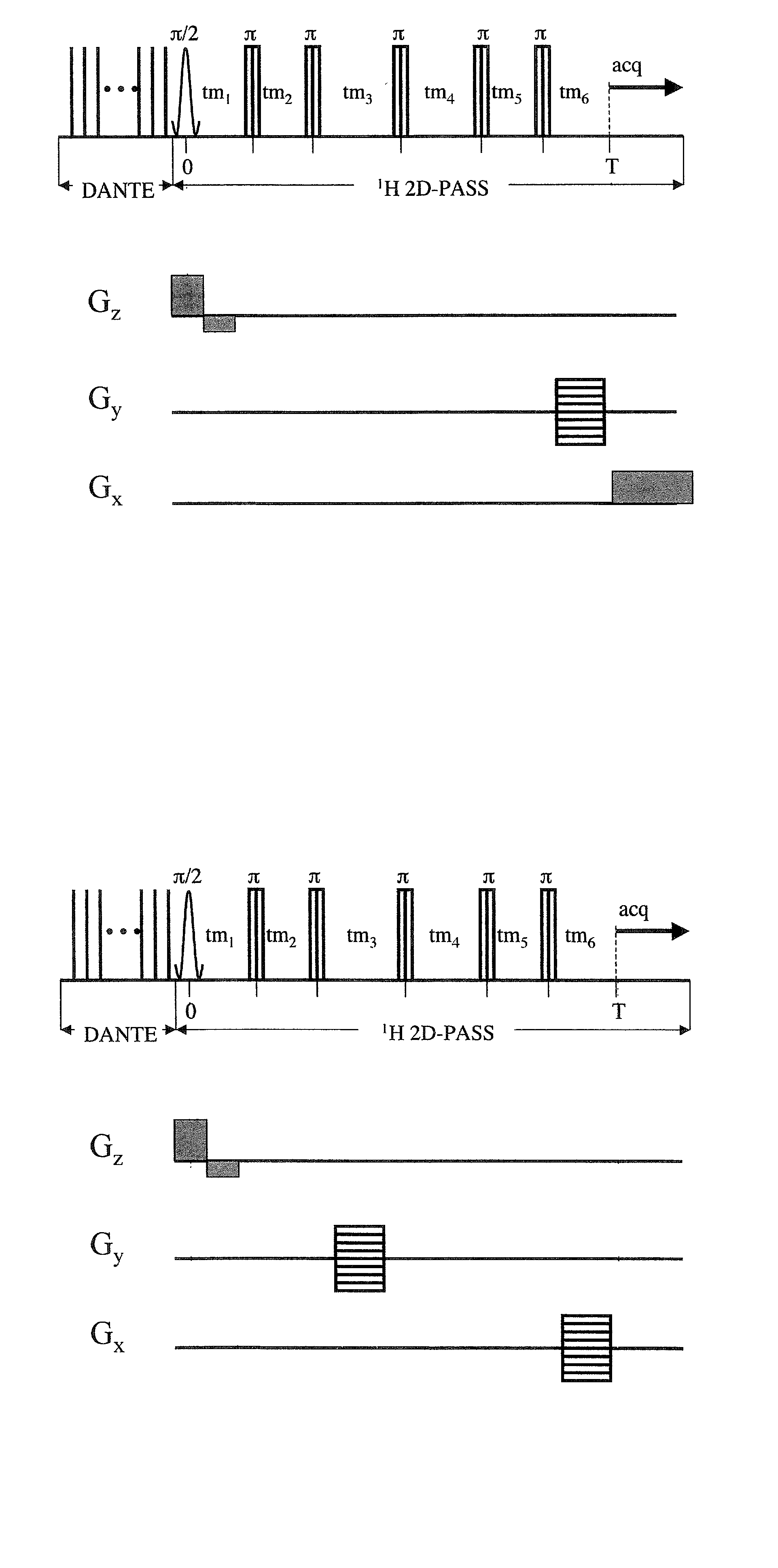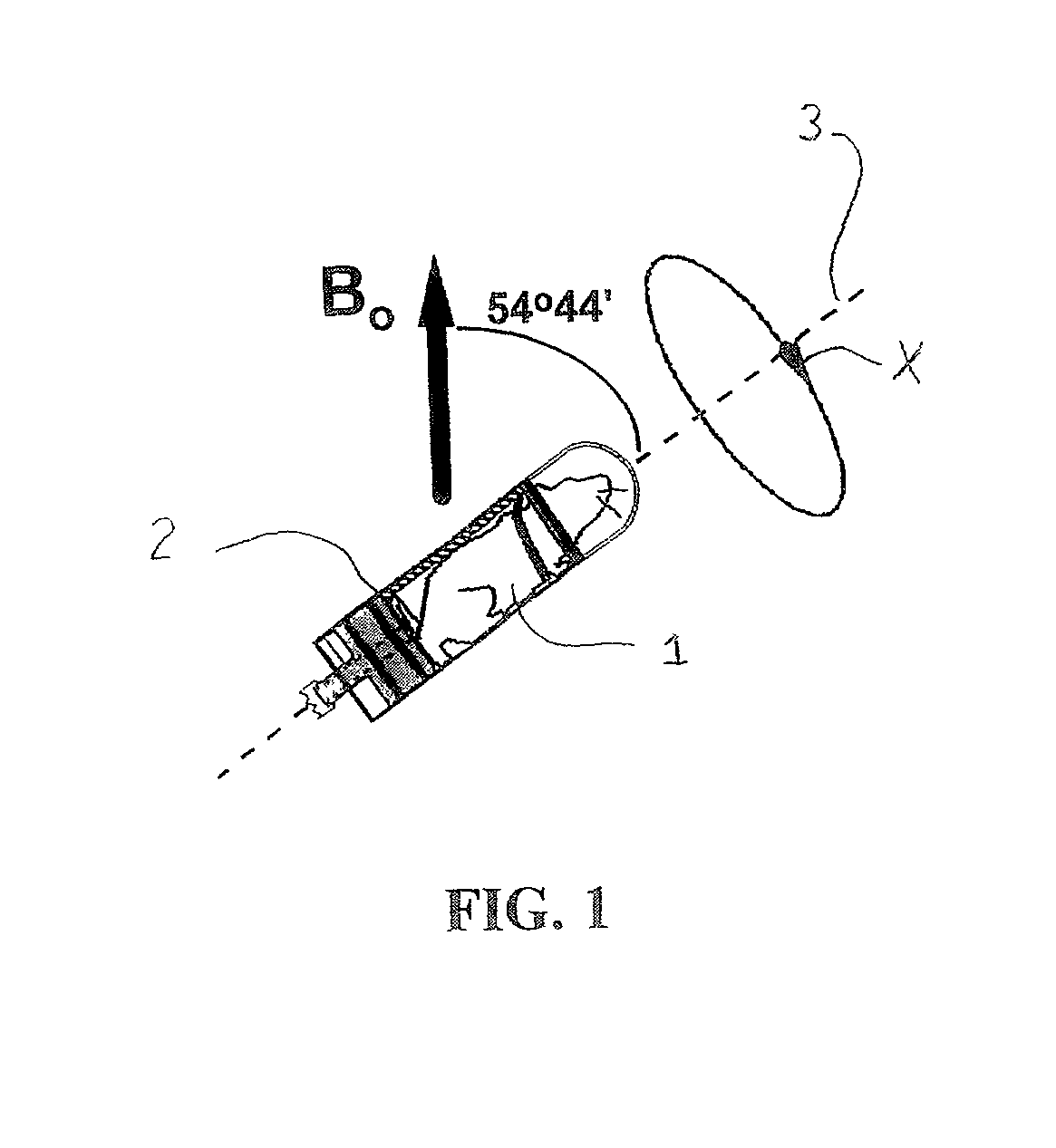Method for high resolution magnetic resonance analysis using magic angle technique
a magnetic resonance analysis and magic angle technology, applied in the field of magnetic resonance analysis, can solve the problems of net nuclear magnetization, population imbalance between energy levels, broadening of the nmr resonance line, etc., and achieve the effect of increasing the resolution of nmr spectra, and increasing the sensitivity of nmr spectra
- Summary
- Abstract
- Description
- Claims
- Application Information
AI Technical Summary
Benefits of technology
Problems solved by technology
Method used
Image
Examples
fifth embodiment
[0063] An example of a magnet configuration for electronically rotating the magnetic field while the biological object is held stationary per the above-described fifth embodiment is shown in FIG. 12. A complementary pair of first RF coils 21 are arranged to generate an alternating magnetic field B.sub.x in the x-direction, given by B.sub.x={square root}2 / 3.multidot.B.sub.0.multidot.sin(.omega..sub.rt). A complementary pair of second RF coils 22 are arranged to generate a static magnetic field B.sub.y in the y-direction, given by B.sub.y=B.sub.0 / {square root}3. A complementary pair of third RF coils 23 are arranged to generate an alternating magnetic field B.sub.z={square root}2 / 3.multidot.B.sub.0.multidot.cos(.omega..sub.rt). DC and AC currents passing through each set of coils 21, 22, 23 produce three mutually orthogonal magnetic field components. A biological object 20 is placed in the center of the coil system. As a result, the overall magnetic field is given by B.sub.0, which ro...
sixth embodiment
[0064] An example of a configuration for physically rotating the magnet while the biological object is held stationary per the above-described sixth embodiment is shown in FIG. 13. A magnet bore 10 defines a void 11 for receiving a biological object (e.g., a human) 12 and a longitudinal axis 13. The longitudinal axis 13 of the magnet bore 10 is aligned at the magic angle of 54.degree.44' relative to the direction of the main magnetic field B.sub.0. The main magnetic field B.sub.0 is generated by the magnet bore 10. The magnet bore 10 may be rotated mechanically around the longitudinal axis 13 as shown by the directional arrow in FIG. 13.
seventh embodiment
[0065] The above-described seventh embodiment involves rotating both the biological object and the main magnetic field in respectively opposite rotational directions. For example, the device depicted in FIG. 12 or FIG. 13 could be modified so that the biological object also rotates. Such rotation allows for the rotational frequency of both the biological object and the main magnetic field to decrease by a factor of two.
[0066] The RF pulse sequence employed in the presently disclosed methods may be any sequence or series of sequences capable of producing a high-resolution spectrum in a slow MAS approach that is substantially free of spinning sidebands. The RF pulse sequences can be repeated during every rotor period (i.e., one 360.degree. rotation of the object) throughout the duration of the scanning. A typical characteristic of these RF pulse sequences may be isotropic-anisotropic chemical shift correlation pulse sequences. Exemplary RF pulse sequences include MAT sequences. These ...
PUM
| Property | Measurement | Unit |
|---|---|---|
| rotational frequency | aaaaa | aaaaa |
| rotational frequency | aaaaa | aaaaa |
| magic angle | aaaaa | aaaaa |
Abstract
Description
Claims
Application Information
 Login to View More
Login to View More - R&D
- Intellectual Property
- Life Sciences
- Materials
- Tech Scout
- Unparalleled Data Quality
- Higher Quality Content
- 60% Fewer Hallucinations
Browse by: Latest US Patents, China's latest patents, Technical Efficacy Thesaurus, Application Domain, Technology Topic, Popular Technical Reports.
© 2025 PatSnap. All rights reserved.Legal|Privacy policy|Modern Slavery Act Transparency Statement|Sitemap|About US| Contact US: help@patsnap.com



